Popcorn vs Smooth Ceiling
Popcorn Ceiling
$350 -$440
(250 sq. ft. prepped and painted)
VS
Smooth Ceiling
$225 - $545
(250 sq. ft. prepped and painted)
Cost to finish a popcorn or smooth ceiling texture varies greatly by region (and even by zip code).
To get free estimates from local contractors, please indicate yours.
Popcorn Ceiling
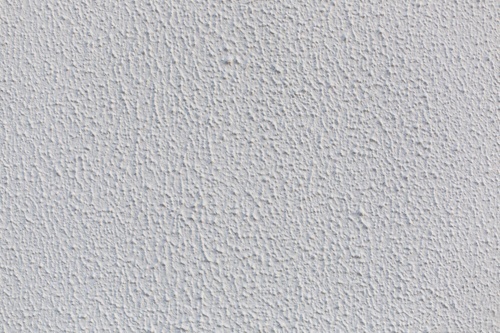
- Hides imperfections
- Deadens noise
- Less bumpy version is gaining favor
- Costs less
- Hard to clean
- May have asbestos if installed before 1977
- Popcorn look is outdated
- Difficult to repair
- Cannot use in bathrooms or kitchens
(250 sq. ft. prepped and painted)
Get free advice and estimates from painters in your city.
Smooth Ceiling
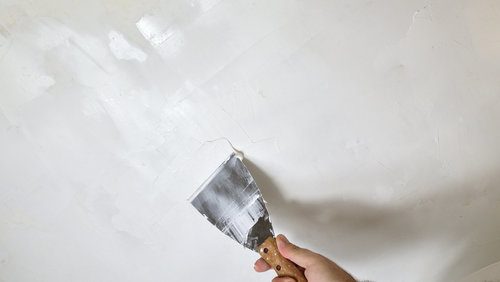
- Easy to clean
- Can be painted yourself
- Visually raises the ceiling
- Smooth ceiling is in style
- Easier to repair
- Can use in bathrooms and kitchens
- Imperfections may show
- Does not deaden noise
(250 sq. ft. prepped and painted)
Get free advice and estimates from painters in your city.
When choosing a new ceiling for your home, it may be difficult to decide because you want it to compliment both the style and décor of the home. In fact, in the late 1970s, popcorn ceilings 1 were very popular because of their ability to hide imperfections and deaden noise. However, the trend passed but has recently revived with a new type of popcorn mixture material made with pieces of polystyrene or Styrofoam. In the sections below, we explain the differences between popcorn and smooth-textured ceilings so that you’re better informed to make a decision.
Aesthetics
The appearance of a popcorn ceiling 1 is irregular and may resemble the texture of popcorn or even cottage cheese. In fact, this ‘’bumpy’’ appearance is ideal for hiding the imperfections of our ceilings because it can cover cracks, leak damage, defects, and even poor drywall 2 workmanship. Even if popcorn ceiling 1 is a good alternative to replace drywall 2, which is distorted, many homeowners prefer other ceiling textures such as smooth or suspended ceilings.
A smooth ceiling can give a room an elegant appearance and blends seamlessly into the walls. Because of the way the paint is applied, it also reflects the natural light more readily on sunny days. Another point is a smooth surface visually raises the ceiling, which makes the room look larger and airier. Since it can be difficult to get a smooth ceiling completely free of imperfections, a flat paint is suggested to help disguise them.
Painting Application Process
Of the two ceilings, the textured ceiling is easier to install because there isn’t as much prep work as there would be for a smooth ceiling. However, the surface will need to be cleaned and primed before starting to apply the popcorn texture, which is bought as a dry mix and then mixed with water. Then, it is applied to the ceiling to get the texture needed with a hopper gun that’s powered by a compressor. This technique provides the best coverage of the ceiling. If more than one coat is going to be used, it needs to dry overnight between coats. It isn’t advisable to paint one thick coat because it could pull away from the ceiling because of the weight.
When a smooth ceiling is applied, there is a lot of prep work beforehand. If there are any small cracks, holes, or minor damage, then they need to be filled. Since the filler will shrink when it dries, it needs to extend past the area that is damaged. Once dry, it must be sanded 3 before a base coat is used to cover the repairs. When the base coat is dry, the next step is to apply a skim coat, which is a thin coat of plaster 4. Then, the last step is to apply the paint color of choice.
Costs
The basic labor for a 250-square foot textured ceiling, including the cost of the texture material but with no additional prep work, costs between $215 and $260 for about 3.5 hours. The ceiling needs 1 gallon of paint for a price of $15 to $30. For extra job supplies such as seam 5 tape, topping compound, outside corner beads, and fasteners 6, the price ranges from $90 to $100. For specialty equipment, which includes renting the compressor, the price is between $30 and $50. The total cost of the project is between $350 and $440.
For a for a 250-square foot smooth ceiling, latex-based paint is used with primer 7 and paint in one with a cost of $70 to $190. The basic labor charge, which includes ceiling prep up to 4 defects per 100 square foot, two coats of paint, and cutting in at the trim molding, is between $140 and $340. Ceiling painting supplies, which include primers 7, cleanup supplies, masking tape, and paper, cost about $15. The total cost of the project is between $225 and $545.
Repairs
If there is a hole in the popcorn ceiling 1, it can be repaired even though it won’t be easy. In fact, the first step is to identify what the problem is because if the issue isn’t found and solved, a reoccurrence of the problem is likely to occur. Then, the area will need to be scraped where it’s damaged and about an inch beyond. Plus, the area will need to be sanded 3, wiped with a damp cloth, have a stain blocker applied, and then the entire area needs to dry thoroughly. Next, the ceiling patch product needs to be used according to the manufacturer’s instructions. In addition, only one coat should be applied at a time. This area needs to dry completely before applying more coats as needed. However, even with a repair job of good quality, the ceiling and repair may never actually match.
A smooth ceiling is easier to repair because a damaged piece can be removed. This is because the piece that is damaged can be cut out and a new piece of drywall 2 can be fitted to match the damaged area. Plus, drywall 2 screws are used to attach it, which is easy to do. Next, a joint compound 8 is applied to smooth over any bumps, and when dry, the area is sanded 3. When the area is completely dry, it can then be painted to match the rest of the ceiling.
Maintenance
The maintenance of a popcorn ceiling can be difficult because of the rough texture. In addition, cobwebs, dirt, and dust can attach themselves to the bumps and crevices making it hard to clean easily. One way to clean it is to run a feather duster over it removing the dust. Another method is to attach the brush attachment to a vacuum and gently go over the ceiling. If the ceiling is rubbed too hard, however, the texture may come loose or crack and fall off.
Another point about popcorn ceilings is that they shouldn’t be put up in bathrooms or kitchens. The fact is, both of these rooms collect a lot of moisture. When moisture is absorbed in a popcorn ceiling, the texture of the ceiling loosens and eventually comes down.
A smooth ceiling is better to have in bathrooms and kitchens, since moisture doesn't affect it, and it’s easier to clean. In a bathroom with a smooth ceiling, paint that is designed to combat moisture can be used.
Asbestos
If a home was built before 1977 and popcorn ceilings were installed, asbestos may be in the mixture. In fact, asbestos 9 was used as a binder in popcorn ceilings before it was banned. Even after the ban, some materials with asbestos 9 that remained in stock was allowed to be sold. If there is a chance that asbestos 9 is in your popcorn ceilings, then a licensed professional must remove it.
Dust
Smooth ceilings don't collect as much dust as popcorn ceilings because of the flat surface. Because a popcorn ceiling has a rough surface, dust will attach itself to the bumps and ridges, which makes keeping it clean difficult.
Noise
Popcorn ceilings are better at noise insulation than smooth ceilings because of the increased surface area. In fact, it can be used in rooms where noise is an issue for the homeowner.
Remodeling Terms Cheat Sheet
Definitions in laymen's terms, cost considerations, pictures and things you need to know.See full cheat sheet.
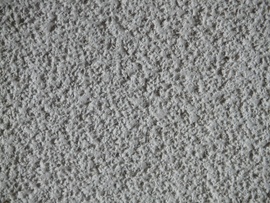 1 Popcorn ceilings: A spray-on or paint-on treatment for the upper interior surface of a room which has a rough curd-like texture and is used to hide imperfections, absorb sound, and reduce echoes
1 Popcorn ceilings: A spray-on or paint-on treatment for the upper interior surface of a room which has a rough curd-like texture and is used to hide imperfections, absorb sound, and reduce echoes
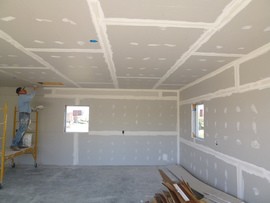 2 Drywall: Type of plasterboard, commonly used to build walls and ceilings, composed of gypsum that is layered between sheets of heavy paper
2 Drywall: Type of plasterboard, commonly used to build walls and ceilings, composed of gypsum that is layered between sheets of heavy paper
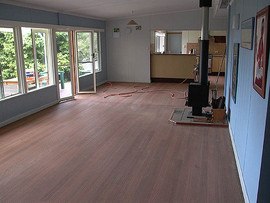 3 Sanded: Process of removing the top surface of a material, such as wood, using sandpaper and/or a specialized sanding machine (for large surface areas)
3 Sanded: Process of removing the top surface of a material, such as wood, using sandpaper and/or a specialized sanding machine (for large surface areas)
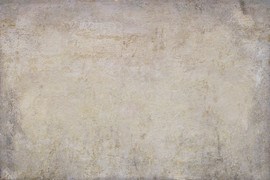 4 Plaster: A paste composed of sand, water, and either lime, gypsum, or cement, which forms a smooth hard surface on walls, ceilings, and other structures upon drying
4 Plaster: A paste composed of sand, water, and either lime, gypsum, or cement, which forms a smooth hard surface on walls, ceilings, and other structures upon drying
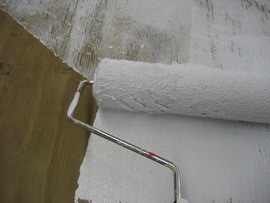 7 Primer: Preparatory coat applied to materials (drywall, wood, metal, etc.) before painting to ensure paint adhesion, extend paint durability, and help seal and protect the surface to be painted
7 Primer: Preparatory coat applied to materials (drywall, wood, metal, etc.) before painting to ensure paint adhesion, extend paint durability, and help seal and protect the surface to be painted
How much does it cost to finish a popcorn or smooth ceiling texture in my city?
Cost to finish a popcorn or smooth ceiling texture varies greatly by region (and even by zip code).
To get free estimates from local contractors, please indicate yours.